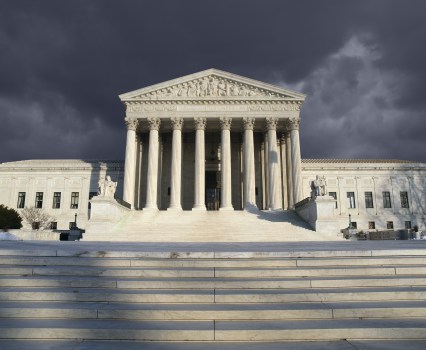Since John Roberts was confirmed as chief justice of the Supreme Court nearly twenty years ago, he has led the Supreme Court with a Janus face. There is the Chief Justice Roberts who is politically attuned and focused on the Court’s legitimacy. This is the Judge Roberts who insisted that judges are no more than umpires at his confirmation hearings in 2005 and the Chief Justice Roberts who avoided partisan rulings when he abandoned his fellow conservatives to provide the fifth vote upholding the Affordable Care Act’s individual mandate in 2012 and wrote the Court’s decisions in two cases upholding subpoenas for then-President Donald Trump’s financial records in 2020.
There also is the Chief Justice Roberts who is determined to entrench conservative legal principles as the federal law of the land. This is the chief justice who has presided over the dismantling of the Voting Rights Act, the invalidation of campaign finance laws, and essentially ended the use of race in college admissions.
It is this Chief Justice Roberts, the conservative ideologue, who led the Court in its last term to continue its assault on federal regulation and expand to an unprecedented degree the legal protection available to the President. It would not be correct to say that the other face of the chief justice was hidden during this term, however. The politically sensitive chief justice was at the helm as well, taking moderate positions in certain cases and steering the Court away from politically controversial decisions that could hurt the Republican Party in the November elections.
Overall, it was a masterful performance of law and politics, one that laid to rest questions raised after the Supreme Court overruled Roe v. Wade in 2022 about whether Roberts still was leading the Court or chasing after it. This two-part article describes the triumphs of Chief Justice Roberts during the 2023-24 term—one that embraced core conservative values, shrugged off claims of partisanship, and left no doubt about its status as the Roberts Court.
It is a story told in three acts. This article sets out the first two acts, which took place in the 2019-20 and 2021-22 terms. In the former term, when Justice Ruth Bader Ginsburg still was on the Court, Roberts eschewed partisanship when writing the Court’s decisions in some of its most politically controversial cases. In the latter term, as noted earlier, Roberts seemed to struggle to restrain the Court, in which conservatives significantly reworked the law in a number of areas—and drew controversy for doing so. Part two examines the final act, the 2023-24 term, in which Roberts re-established himself as the leader of the Court.
The 2019-20 Term: The Trump Subpoena Cases & Two Other Administrative Law Cases
Act I occurred at the end of the 2019-2020 term, when Justice Ginsburg still was on the Court. During the term, the Court decided three cases involving subpoenas issued by Congress and the New York District Attorney’s Office seeking then-President Donald Trump’s records. (Two cases involved subpoenas issued by congressional committees, which were consolidated for argument and decision.) Oral argument occurred by phone early in the pandemic, in May 2020, with the public able to listen in.
The separation-of-powers issues raised by the cases were significant and, in the congressional subpoena cases, novel. Roberts navigated the terrain with the sophistication of a seasoned diplomat. He wrote the Court’s opinion rejecting Trump’s efforts to quash the subpoenas in each case. Justices Clarence Thomas and Samuel Alito dissented in both cases, but that was hardly a surprise. The political and legal consensus that informed the Supreme Court’s unanimous ruling against President Richard Nixon in the 1974 case involving the special prosecutor’s subpoena for White House records dissolved sometime this century.
In 2020, a presidential election year, Chief Justice Roberts’ decisions in the subpoena cases represented the triumph of judicial statesmanship. Justices appointed by presidents from both parties voted together to rule against the sitting President in cases involving vital separation of powers issues. The theme of Roberts’s opinions is that while there are special considerations involved in seeking information from the President, he nevertheless was subject to the law. At the same time, the Court’s remand of the cases back to the lower courts for further proceedings ensured that the records would not be produced until after the November election.
Two other administrative law cases from the 2019-20 term are worth noting: In Seila Law, LLC v. Consumer Prot. Fin. Bureau, the Supreme Court addressed the President’s removal authority under Article II of the Constitution. The Court held, by a 5-4 vote that divided along party lines, that the structure of the Consumer Financial Protection Bureau (CFPB), with a single director who could be terminated only for cause, was an unconstitutional violation of separation-of-powers. It further held that the “for cause” provision in the statute authorizing the CFPB was severable. After the Court’s decision, the CFPB could continue to operate; the only change was that the President could dismiss the Director for any reason. Roberts wrote the Court’s opinion while Justice Elena Kagan wrote a powerful but respectful dissent.
The other case concerned the Trump administration’s decision to rescind the Deferred Action for Childhood Arrivals (DACA) program, an immigration measure adopted by President Barack Obama. The conventional wisdom was that a conservative Supreme Court would uphold a Republican President’s decision to terminate an immigration program championed by a Democratic President.
The conventional wisdom did not pan out. Roberts wrote the Court’s opinion in a case decided by a 5-4 vote—one that sustained an arbitrary and capricious challenge to the Department of Homeland Security’s rescission decision. More succinctly: The Court ruled against the Trump administration, requiring it to do more to justify rescinding DACA. Roberts was joined by the Court’s four justices appointed by Democratic Presidents while the other four justices, all appointed by Republican Presidents, dissented.
In what would turn out to be Justice Ginsburg’s final term (and therefore the last term of a 5-4 Court), judicial statesmanship prevailed, with Roberts writing the Court’s opinion in the four cases previously discussed. In three of these cases, the Court ruled against President Trump or his administration, with justices appointed by Presidents from both parties in the majority. The 2019-20 term highlighted the first face of the chief justice, the one focused on preserving the Court’s institutional reputation and skirting the political fray.
In September 2020, Justice Ginsburg died. It took President Trump and the Republican Senate a little over a month to nominate and confirm Amy Coney Barrett as her replacement. Eight days before the election, the composition of the Court changed. Now there were six justices appointed by Republican Presidents and three by Democratic Presidents.
The 2021-22 Term: Abortion, Guns, and the Major Questions Doctrine
The significance of Justice Barrett’s appointment became apparent by the end of the 2021-22 term—the setting for Act II. The theme of this term was not the triumph of judicial statesmanship. Instead, it was whether the era of the Roberts Court was over. A number of developments prompted this query, most notably the Court’s overruling Roe v. Wade, which held that there was a federal constitutional right to abortion. In Dobbs v. Jackson Women’s Health Organization, involving a challenge to a Mississippi law prohibiting most abortions after fifteen weeks, the Court decided, in the words of Justice Alito, that it was “time to heed the Constitution and return the issue of abortion to the people’s elected representatives.”
Roberts did not join the Court’s opinion but concurred in the judgment and wrote a separate opinion. While Roberts agreed that the Mississippi law should be upheld, he argued that it was neither necessary nor appropriate to overrule Roe. Roberts stated that he would “discard[]” the “viability line established by Roe” and Planned Parenthood of Southeastern PA v. Casey but not “go further.” However, he continued, the Court should not overrule Roe “out of adherence to a simple yet fundamental principle of judicial restraint.” In language that later would be quoted by dissenting justices this past term, Roberts explained, “If it is not necessary to decide more to dispose of a case, then it is necessary not to decide more.”
When the Court issued its decision in Dobbs, Adam Liptak’s article in the New York Times described it as “The Day Chief Justice Roberts Lost His Court.”
Other Court observers wrote similar pieces even before the Court released its decision in Dobbs—the final decision, that is, not the leaked draft that circulated more than a month before. Professor Stephen Vladek wrote an opinion piece for the Times in April 2022 describing Roberts’s disagreement with the Court’s orders in a number of shadow docket cases. In several of these cases, Roberts dissented, as did the three justices appointed by Democratic Presidents. Vladeck’s assessment was blunt: “The Roberts Court is over.”
Even in two of the most important cases of the 2021-22 term when Roberts voted with the conservative majority, he seemed to be applying the brakes, trying to limit the scope of the Court’s decision. In a case decided by a 6-3 vote along partisan lines, Justice Clarence Thomas dramatically expanded the Second Amendment right to bear arms in Bruen v. New York. Roberts joined Justice Kavanaugh’s concurrence insisting that the decision was not as broad as critics feared. “The Court’s decision does not prohibit States from imposing licensing requirements for carrying a handgun for self-defense,” Kavanaugh wrote.
With the power of assignment, Roberts gave himself the most significant administrative law decision of the term. He wrote the Court’s opinion expressly articulating for the first time the anti-regulatory Major Questions Doctrine (MQD) to invalidate the Environmental Protection Agency’s Clean Power Plan, which would have required coal-fired power plants to reduce their own production of electricity or subsidize protection by other sources. The MQD authorizes judges to decide whether an administrative measure involves a “major question”—that is, a question of “vast economic and political significance.” If it does, the judge may set aside the agency’s action if it was not clearly authorized by Congress. The vote in West Virginia v. EPA was 6-3, along partisan lines, with Justice Kagan denouncing the Court for appointing “itself—instead of Congress or the expert agency—the decision-maker on climate policy.”
Writing in The Wahington Monthly, Professor Peter Shane described the Major Questions Doctrine as “fuzz[y]”—an apt description that described Roberts’ “I know it when I see it” approach, which allowed the Court to continue to develop the law in this area. Compared to Justice Neil Gorsuch’s concurrence in the Clean Power Plan case, which provided detailed guidance on what constitutes a major question and whether the administrative action was statutorily authorized, Roberts’ opinion was relatively restrained.
Politically, Dobbs was by far the Court’s most significant decision of the 2021-22 term. About four months after the term ended, the Democrats outperformed expectations in the 2022 midterm elections. Voters’ response to the overruling of Roe was a critical factor in the Republicans not gaining seats at any level of government except the House of Representatives.
How did Chief Justice Roberts respond to developments in the 2021-22 term? Part two addresses that question, focusing on the Court’s 2023-24 term.
#Chief #Justice #Roberts #Stood #Term #Interested #Advancing #Conservative #Legal #Agenda #Promoting #Judicial #Statesmanship #Rodger #Citron #Verdict










